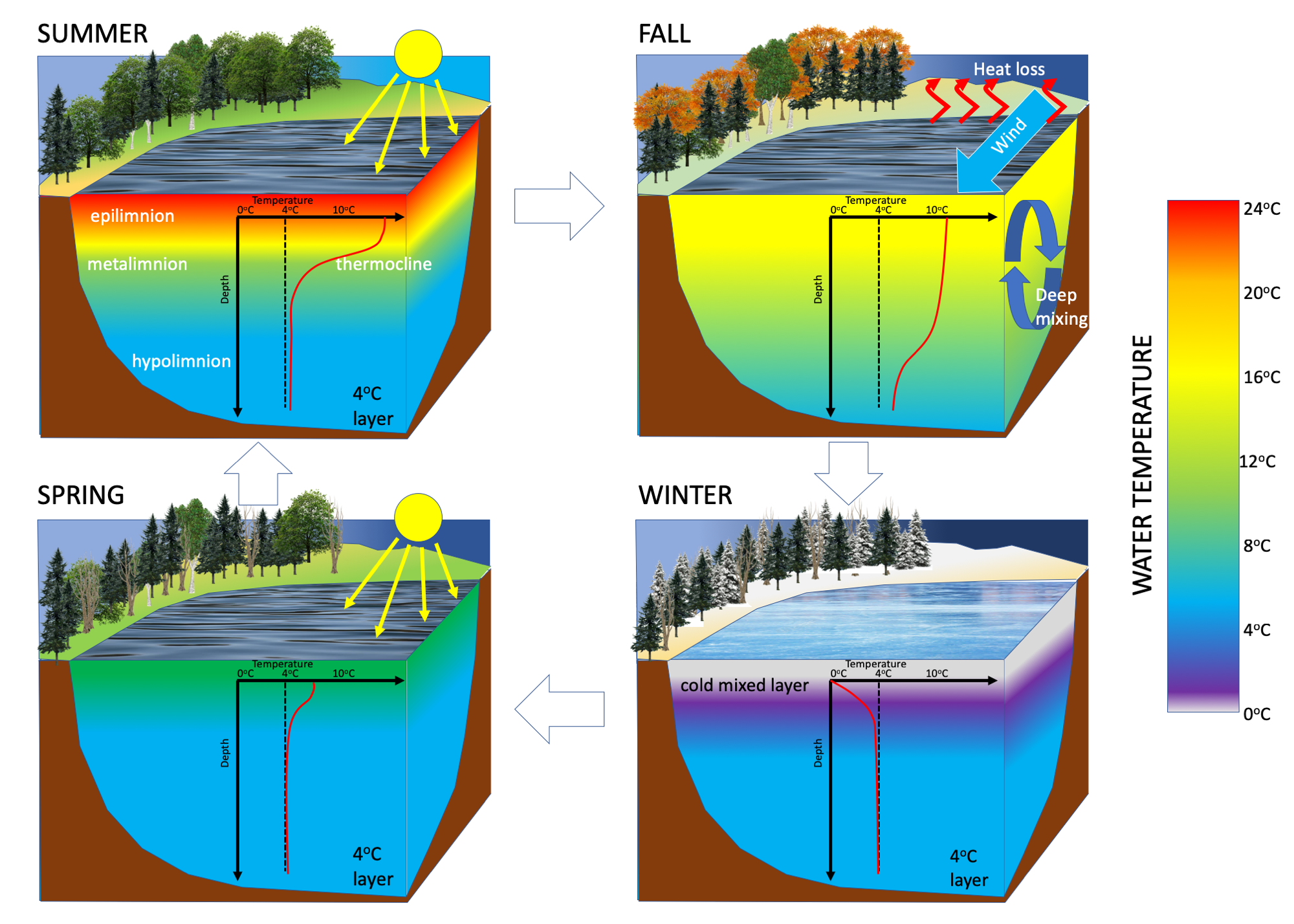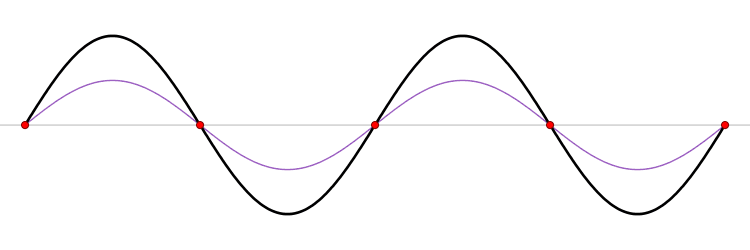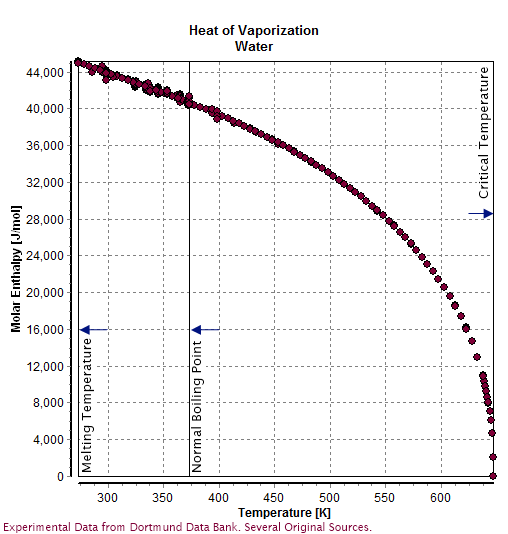|
Dimictic Lake
A dimictic lake is a body of freshwater whose difference in temperature between surface and bottom layers becomes negligible twice per year, allowing all strata of the lake's water to circulate vertically. All dimictic lakes are also considered holomictic, a category which includes all lakes which mix one or more times per year. During winter, dimictic lakes are covered by a layer of ice, creating a cold layer at the surface, a slightly warmer layer beneath the ice, and a still-warmer unfrozen bottom layer, while during summer, the same temperature-derived density differences separate the warm surface waters (the epilimnion), from the colder bottom waters (the hypolimnion). In the spring and fall, these temperature differences briefly disappear, and the body of water overturns and circulates from top to bottom. Such lakes are common in mid-latitude regions with temperate climates. Examples of dimictic lakes * Lake Mendota * Lake Superior * Lake Simcoe * Lake Opeongo * Loch L ... [...More Info...] [...Related Items...] OR: [Wikipedia] [Google] [Baidu] |
Holomictic
Holomictic lakes are lakes that have a uniform temperature and density from surface to bottom at a specific time during the year, which allows the lake waters to mix in the absence of stratification. Details Holomictic lakes mix at least occasionally, in contrast to meromictic lakes. Most lakes on Earth are holomictic; meromictic lakes are rare, although they may be less rare than commonly thought. Amictic lakes are sealed off by ice and never mix. There are five types of holomictic lakes: * Polymictic (mixing many times annually) * Cold Monomictic (mixing once annually; exhibiting negative stratification) * Warm Monomictic (mixing once annually; exhibiting positive stratification) * Dimictic (mixing twice annually) * Oligomictic (mixing less than once annually) See also * Thermocline A thermocline (also known as the thermal layer or the metalimnion in lakes) is a distinct layer based on temperature within a large body of fluid (e.g. water, as in an ocean or lake; or ... [...More Info...] [...Related Items...] OR: [Wikipedia] [Google] [Baidu] |
Seiche
A seiche ( ) is a standing wave in an enclosed or partially enclosed body of water. Seiches and seiche-related phenomena have been observed on lakes, reservoirs, swimming pools, bays, harbors, caves, and seas. The key requirement for formation of a seiche is that the body of water be at least partially bounded, allowing the formation of the standing wave. The term was promoted in 1890 by the Swiss hydrologist François-Alphonse Forel, who was the first to make scientific observations of the effect in Lake Geneva. The word had apparently long been used in the region to describe oscillations in alpine lakes. According to Wilson (1972), this Swiss French dialect word comes from the Latin word meaning "dry", i.e., as the water recedes, the beach dries. The French word or (dry) descends from the Latin. Seiches in harbours can be caused by ''long-period'' or '' infragravity waves'', which are due to subharmonic nonlinear wave interaction with the wind waves, having periods ... [...More Info...] [...Related Items...] OR: [Wikipedia] [Google] [Baidu] |
Polymictic
Polymictic lakes are holomictic lakes that are too shallow to develop thermal stratification; thus, their waters can mix from top to bottom throughout the ice-free period. Polymictic lakes can be divided into cold polymictic lakes (i.e., those that are ice-covered in winter), and warm polymictic lakes (i.e., polymictic lakes in regions where ice-cover does not develop in winter). While such lakes are well-mixed on average, during low-wind periods, weak and ephemeral stratification can often develop. See also * Amictic lake * Holomictic lake * Meromictic lake * Monomictic lake * Dimictic lake * Thermocline A thermocline (also known as the thermal layer or the metalimnion in lakes) is a distinct layer based on temperature within a large body of fluid (e.g. water, as in an ocean or lake; or air, e.g. an atmosphere) with a high gradient of distinct te ... * References External links "Circulation: annual patterns of dimictic lakes" at Encyclopædia Britannica Online Lakes by ... [...More Info...] [...Related Items...] OR: [Wikipedia] [Google] [Baidu] |
Monomictic
Monomictic lakes are holomictic lakes that mix from top to bottom during one mixing period each year. Monomictic lakes may be subdivided into cold and warm types. Cold monomictic lakes Cold monomictic lakes are lakes that are covered by ice throughout much of the year. During their brief "summer", the surface waters remain at or below 4 °C. The ice prevents these lakes from mixing in winter. During summer, these lakes lack significant thermal stratification, and they mix thoroughly from top to bottom. These lakes are typical of cold-climate regions (e.g. much of the Arctic). An example of a cold monomictic lake is Great Bear Lake in Canada. Warm monomictic lakes Warm monomictic lakes are lakes that never freeze, and are thermally stratified throughout much of the year. The density difference between the warm surface waters (the epilimnion) and the colder bottom waters (the hypolimnion) prevents these lakes from mixing in summer. During winter, the surface waters cool to ... [...More Info...] [...Related Items...] OR: [Wikipedia] [Google] [Baidu] |
Meromictic
A meromictic lake is a lake which has layers of water that do not intermix. In ordinary, holomictic lakes, at least once each year, there is a physical mixing of the surface and the deep waters. The term ''meromictic'' was coined by the Austrian Ingo Findenegg in 1935, apparently based on the older word ''holomictic''. The concepts and terminology used in describing meromictic lakes were essentially complete following some additions by G. Evelyn Hutchinson in 1937. Characteristics Most lakes are ''holomictic'': at least once per year, the surface and the deep waters mix. In monomictic, monomictic lakes, the mixing occurs once per year; in dimictic lake, dimictic lakes, it occurs twice a year (typically spring and autumn), and in polymictic, polymictic lakes, the mixing occurs several times a year. In meromictic lakes, the layers of water can remain unmixed for years, decades, or centuries. Meromictic lakes can usually be divided into three sections or layers. The bottom la ... [...More Info...] [...Related Items...] OR: [Wikipedia] [Google] [Baidu] |
Holomictic
Holomictic lakes are lakes that have a uniform temperature and density from surface to bottom at a specific time during the year, which allows the lake waters to mix in the absence of stratification. Details Holomictic lakes mix at least occasionally, in contrast to meromictic lakes. Most lakes on Earth are holomictic; meromictic lakes are rare, although they may be less rare than commonly thought. Amictic lakes are sealed off by ice and never mix. There are five types of holomictic lakes: * Polymictic (mixing many times annually) * Cold Monomictic (mixing once annually; exhibiting negative stratification) * Warm Monomictic (mixing once annually; exhibiting positive stratification) * Dimictic (mixing twice annually) * Oligomictic (mixing less than once annually) See also * Thermocline A thermocline (also known as the thermal layer or the metalimnion in lakes) is a distinct layer based on temperature within a large body of fluid (e.g. water, as in an ocean or lake; or ... [...More Info...] [...Related Items...] OR: [Wikipedia] [Google] [Baidu] |
Amictic
Amictic lakes are "perennially sealed off by ice, from most of the annual seasonal variations in temperature." Amictic lakes exhibit inverse cold water stratification whereby water temperature increases with depth below the ice surface 0 °C (less-dense) up to a theoretical maximum of 4 °C (at which the density of water is highest). Hutchinson–Löffler (1956) classified amictic and other types of lakes based on physical/thermal processes. These processes are influenced by solar radiation and wind. They are strongly tied with seasonality and thus associated with latitude and altitude. Amictic lakes occur in Arctic, Antarctic, and alpine regions and due to permanent ice-cover, these physical/thermal influences have a limited effect on circulation in the water column. For this reason, amictic lakes are commonly referred to as lakes that ''never'' mix. ''"Mixing"'' in this context, however, refers to homogenization of the water column and so the term ''"amictic"'' i ... [...More Info...] [...Related Items...] OR: [Wikipedia] [Google] [Baidu] |
Properties Of Water
Water () is a Chemical polarity, polar inorganic compound that is at room temperature a tasteless and odorless liquid, which is nearly colorless apart from Color of water, an inherent hint of blue. It is by far the most studied chemical compound and is described as the "universal solvent" and the "solvent of life". It is the most abundant substance on the surface of Earth and the only common substance to exist as a ice, solid, liquid, and water vapor, gas on Earth's surface. It is also the third most abundant molecule in the universe (behind Hydrogen, molecular hydrogen and carbon monoxide). Water molecules form hydrogen bonds with each other and are strongly polar. This polarity allows it to dissociate ions in salts and bond to other polar substances such as alcohols and acids, thus dissolving them. Its hydrogen bonding causes its many unique properties, such as having a solid form less dense than its liquid form, a relatively high boiling point of 100 °C for its molar ... [...More Info...] [...Related Items...] OR: [Wikipedia] [Google] [Baidu] |
Kelvin Wave
A Kelvin wave is a wave in the ocean, a large lake or the atmosphere that balances the Earth's Coriolis force against a topographic boundary such as a coastline, or a waveguide such as the equator. A feature of a Kelvin wave is that it is non-dispersive, i.e., the phase speed of the wave crests is equal to the group speed of the wave energy for all frequencies. This means that it retains its shape as it moves in the alongshore direction over time. A Kelvin wave (fluid dynamics) is also a long scale perturbation mode of a vortex in superfluid dynamics; in terms of the meteorological or oceanographical derivation, one may assume that the meridional velocity component vanishes (i.e. there is no flow in the north–south direction, thus making the momentum and continuity equations much simpler). This wave is named after the discoverer, Lord Kelvin (1879). Coastal Kelvin wave In a stratified ocean of mean depth ''H'', whose height is perturbed by some amount ''η'' (a functio ... [...More Info...] [...Related Items...] OR: [Wikipedia] [Google] [Baidu] |
Sverdrup Wave
A Sverdrup wave (also known as Poincaré wave, or rotational gravity waveKundu, P. K., and L. M. Cohen. "Fluid mechanics, 638 pp." Academic, Calif (1990).) is a wave in the ocean, or large lakes, which is affected by gravity and Earth's rotation (see Coriolis effect). For a non-rotating fluid, shallow water waves are affected only by gravity (see Gravity wave), where the phase velocity of shallow water gravity wave (''c'') can be noted as : c = (gH)^ and the group velocity (''c''g) of shallow water gravity wave can be noted as : c_\mathrm=(gH)^ i.e. c=c_\mathrm where ''g'' is gravity, ''λ'' is the wavelength and ''H'' is the total depth. Derivation When the fluid is rotating, gravity waves with a long enough wavelength (discussed below) will also be affected by rotational forces. The linearized, shallow-water equations with a constant rotation rate, ''f0'', areVallis, Geoffrey K. Atmospheric and oceanic fluid dynamics: fundamentals and large-scale circulation. Cambridge Univ ... [...More Info...] [...Related Items...] OR: [Wikipedia] [Google] [Baidu] |
Lake Ontario
Lake Ontario is one of the five Great Lakes of North America. It is bounded on the north, west, and southwest by the Canadian province of Ontario, and on the south and east by the U.S. state of New York (state), New York. The Canada–United States border spans the centre of the lake. On the Canadian side, the major cities are Kingston, Ontario, Kingston, Mississauga, Toronto, Hamilton, Ontario, Hamilton, and St. Catharines. On the American side, the major cities are Rochester, New York, Rochester and Watertown, New York, Watertown. The last in the Great Lakes chain, Lake Ontario serves as the outlet to the Atlantic Ocean via the Saint Lawrence River, comprising the western end of the Saint Lawrence Seaway. Its primary inlet is the Niagara River from Lake Erie. The Long Sault Dam, Long Sault control dam, primarily along with the Moses-Saunders Power Dam regulates the water level of the lake. The name ''Ontarí'io'' is most often translated from Wyandot language, Huron as "beauti ... [...More Info...] [...Related Items...] OR: [Wikipedia] [Google] [Baidu] |
Lake Michigan
Lake Michigan ( ) is one of the five Great Lakes of North America. It is the second-largest of the Great Lakes by volume () and depth () after Lake Superior and the third-largest by surface area (), after Lake Superior and Lake Huron. To the east, its basin is conjoined with that of Lake Huron through the wide and deep Straits of Mackinac, giving it the same surface elevation as its eastern counterpart; hydrologically, the two bodies are Lake Michigan–Huron, a single lake that is, by area, the largest freshwater lake in the world. Lake Michigan is the only Great Lake located fully in the United States; the other four are shared between the U.S. and Canada. It is the world's List of lakes by area, largest lake, by area, located fully in one country, and is shared, from west to east, by the U.S. states of Wisconsin, Illinois, Indiana, and Michigan. Ports along its shores include Chicago, Illinois, Gary, Indiana, Gary, Indiana, Milwaukee and Green Bay, Wisconsin, Green Bay, Wis ... [...More Info...] [...Related Items...] OR: [Wikipedia] [Google] [Baidu] |





